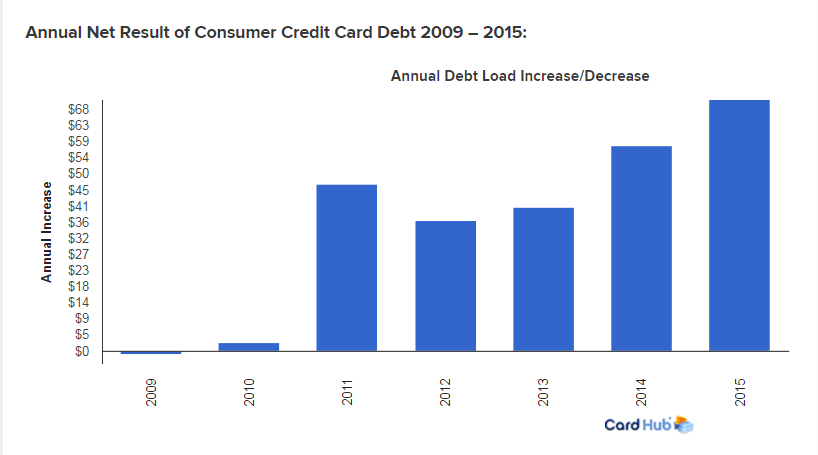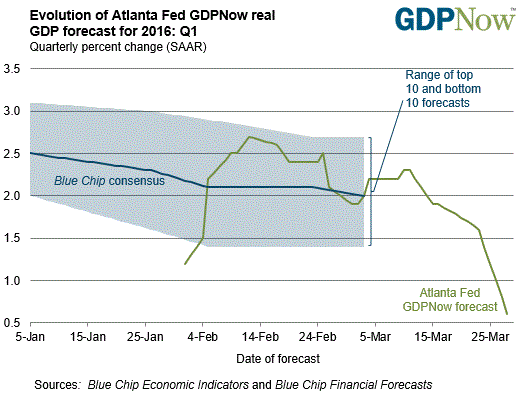Faux Growth Recovery Nearly 7 years have elapsed since the official end of the Great Recession. By now it’s painfully obvious the rising tide of economic recovery has failed to lift all boats. In fact, many boats bottomed out on the rocks in early 2009 and have been taking on water ever since. Last week, for instance, it was reported that U.S. credit card debt topped 7 billion in the fourth quarter of 2015. That’s up billion from the year before. Shouldn’t the economic recovery allow consumers to pay down their debts? Annual increase in credit card debt load….via cardhub (more data here) – click to enlarge. Indeed, it should, if only the economic recovery was the result of real, economic growth. To the contrary, the recovery has been faux growth driven by cheap Fed credit and financial engineering. Mutual increases in prosperity haven’t occurred. In particular, those outside the financial services business, and other bubble industries, like government lobbyists, have largely missed out on any increase in income or living standard. Good paying professional jobs that vaporized during the downturn have been replaced with low paying service jobs. Consumers have used credit card debt to pick up the slack. Unfortunately, this short term solution sets up consumers for pain in the future.
Topics:
MN Gordon considers the following as important: Monetary Metals, On Economy
This could be interesting, too:
Keith Weiner writes What’s In Your Loan?
MN Gordon writes Did You Make Janet Yellen Rich?
MN Gordon writes Janet Yellen: Too Dumb To Stop
Jayant Bhandari writes The Decline of the Third World
Faux Growth Recovery
Nearly 7 years have elapsed since the official end of the Great Recession. By now it’s painfully obvious the rising tide of economic recovery has failed to lift all boats. In fact, many boats bottomed out on the rocks in early 2009 and have been taking on water ever since.
Last week, for instance, it was reported that U.S. credit card debt topped $917 billion in the fourth quarter of 2015. That’s up $71 billion from the year before. Shouldn’t the economic recovery allow consumers to pay down their debts?
 Annual increase in credit card debt load….via cardhub (more data here) – click to enlarge.
Annual increase in credit card debt load….via cardhub (more data here) – click to enlarge.
Indeed, it should, if only the economic recovery was the result of real, economic growth. To the contrary, the recovery has been faux growth driven by cheap Fed credit and financial engineering. Mutual increases in prosperity haven’t occurred.
In particular, those outside the financial services business, and other bubble industries, like government lobbyists, have largely missed out on any increase in income or living standard. Good paying professional jobs that vaporized during the downturn have been replaced with low paying service jobs. Consumers have used credit card debt to pick up the slack.
Unfortunately, this short term solution sets up consumers for pain in the future. At some point, as debt increases faster than incomes, the ability to pay down the principal becomes near impossible. Even making the minimum payment becomes more and more difficult as new debt is added to the burden each month.
Playing with Fire
“We’re playing with fire now,” said Odysseas Papadimitriou, chief executive of credit statistics and analysis site CardHub. “Either an unexpected economic downtown or the continuation of current spending and payment trends could be enough to unleash an avalanche of defaults.”
Papadimitriou is correct in his assertion we are playing with fire and that the continuation of current trends could unleash an avalanche of defaults. But his statement that there could be an “unexpected” economic downturn doesn’t appreciate the natural rhythms of an economy. Specifically, economic downturns are normal occurrences – they should be expected, not unexpected.
From what we gather there has been roughly 12 recessions (assuming the 1980 and 1981-82 recessions were two distinct events) in the United States in the post-World War II era. The average interval between these recessions has been about 58 months. Based on the official end date of the Great Recession of June 2009, we are currently 82 months into the current recovery. In other words, we are due for a downturn. What’s more, we may presently be entering one.
 GDPThen generally looked better than GDPNow does.
GDPThen generally looked better than GDPNow does.
According the Atlanta Fed’s March 28 GDPNow model forecast, real GDP growth in the first quarter of 2016 is estimated to be 0.6 percent. By the time you read this, the April 1 update will likely have been posted. You can take a look at the Atlanta Fed’s latest forecast here.
The point is, GDP is meager. Moreover, present credit card debt is unsustainable. The potential for an avalanche of defaults is already high, regardless of if there’s a recession. Yet, at this point in the recovery, the looming potential for a recession is highly likely. Hence, an avalanche of credit card defaults is practically certain. But that’s not all…
The Other Problem with Debt No One is Talking About
The other problem with expanding consumer debt that is rarely, if ever, mentioned is that it accompanies expanding waist lines. You can chart the strength of the relationship over time with a near perfect +1.0 positive correlation. Why is this?
We don’t know for sure. We haven’t studied the data. Nor have we researched the causation. But gut feel tells us it has something to do with discipline. More precisely lack of discipline.
 Stricken with credit gut
Stricken with credit gut
Photo credit: MartesiaBezuidenhout
For example, the inclination to charge the purchase of a new flat screen TV complements the proclivity to jumbo size a mega gulp soda pop. Both are entirely unnecessary. But they go hand in hand.
Saving up for a flat screen and resisting the jumbo size option takes the sort of self-restraint that’s absent from our debt saturated society. Of course, the federal government is the worst offender. Even with their bloated budgets they still need a half trillion dollar annual deficit to keep the machine humming along.
No doubt, the promises politicians have made to voters for a comfortable retirement and free drugs are at the heart of matter. Similar to credit card debt, the promises stack up each month and each year like dead wood in the Angeles National Forest. At some point all it takes is the strike of a single match and the whole mountain conflagrates in a blazing inferno.
Charts by: CreditHub, Atlanta Federal Reserve
Chart and image captions by PT
M N. Gordon is the editor and publisher of the Economic Prism.
Full story here